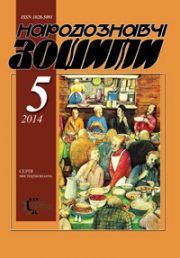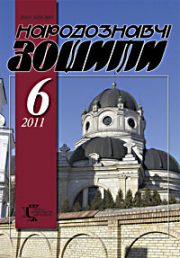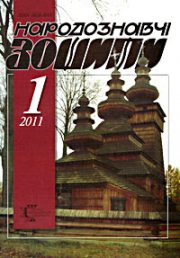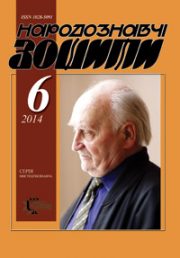The Ethnology Notebooks. 2023. № 1 (169), 163—180
UDK 7.046.3(477)”17″:27-312.47
DOI https://doi.org/10.15407/nz2023.01.163
DEVELOPMENT OF THE IMMACULATE CONCEPTION’S ICONOGRAPHY IN UKRAINIAN ART OF THE 18TH CENTURY
LЕVYTSKA Mariana
- ОRCID.ID: http://orcid.org/0000-0002-0977-4470
- PhD, Assistant professor,
- Senior Research Associate,
- Department of Art History,
- The Ethnology Institute UNAS,
- 15, Svobody Avenue, 79000, Lviv, Ukraine,
- Contacts: e-mail: m.levytska@gmail.com
Abstract. Introduction. Theological thoughts about the role and significance of the Virgin Mary as Mother of God in Mariology had been developed for almost two thousand years of the Eastern and Western ecclesiastical traditions. Whereas the Ukrainian art of the 17th—18th centuries was closely connected with religious culture and was presented mainly in religious forms, particularly in forms of honouring the Mother of God, the interest in a specific type of Marian iconography is quite reasonable.
Problem statement. Ukrainian territory was always the stage of clashes and interactions for different religions and different cultures. In a such context Marian’s devotion practices, veneration of miraculous icons, and pilgrimage sites were the potential locus for dialogue within the heterogeneous society. Conversely, this dialogue was reflected in the artistic forms, in the assimilation of the Latin samples in the Orthodox or Uniate ecclesiastical art tradition.
Purpose. The article has examined the development of the iconography of the Immaculate Conception in Ukrainian religious art of the 18th century through the optics of biblical references, theological texts, and the ecclesiastical imagery of the Orthodox and Catholic traditions of the 17th —18th centuries. The research focuses on typical examples of painting and graphics from the regions of Halychyna, Volhynia, and the Right Bank, in which the specified iconographic motif and its variations were represented.
Methods. The analytic and descriptive approaches have been combined in the research to reveal the aspects of historical, theological, and artistic attitudes within the definite religious topic. The iconological and hermeneutic methods, based on studies of religious culture, were used to analyze particular artworks with references between textual and pictorial means.
Results. The first changes regarding the Marian topics in Ukrainian icon painting appeared in the late 16th century in the scenes of the Twelve feasts. In particular, the Carmelites made an essential contribution to spreading the new iconography.
Conclusions. The given review of Ukrainian literary Baroque acknowledged that from the middle of the 17th century, Marian topics and symbolism took a very important place in the spiritual and aesthetic space of Ukrainian culture, and this process was quite commensurate with the devotional Marian practices of the Catholic world. The theological and dogmatic image of the Virgin Mary perfectly corresponded to the general cultural parameters of the Baroque: with its unique synthesis of the transcendental and the earthly, the irrational and the rational, the superhuman and the natural, which were harmoniously «arranged « in the image of the Virgin Mary.
Keywords: iconography, the Immaculate Conception, Biblical sources, symbolics, emblematic rhetoric.
Received 29.12.2022
REFERENCES
- (1958). Encyclopedia Mariana: Theotokos (Pp. 314—331). (2d ed.). Genova; Milano: Bevilacqua&Solari Edizioni; Editrice Massimo.
- (1909). Apocrypha and Legends from Ukrainian Manuscripts: collected, arranged and explained by Ivan Franko (Vol. 4, pp. 350—355). Lviv: nakl. Nukovoho Tovarystva T. Shevchenka [in Ukrainian].
- Schurat, V. (1910). Marian cult at the Ukrainian Lands of the Old Polish State. L’viv [in Ukrainian].
- Velykyj, Athanasius, G. (1950). The Cult of Holy Madonna in Ukraine. In: International Marian Academy; Acts of Mariology Congress (Pp. 221—232). Rome [in Italian].
- Hryn’okh, o. Ivan. (1970). Theological Foundations of the Veneration of the Holy Mother of God. Bohosloviia. (Vol. 34, pp. 152—187). Rym [in Ukrainian].
- Isichenko, arkh. Ihor. (2011). The History of Ukrainian Literature: Baroque Era 17—18th centuries. National University Kyiv-Mohylian Academy: L’viv; Kyiv; Kharkiv [in Ukrainian].
- Kosiv, R. (2021). Ukrainian Iconography of the Mother of God: A Handbook. L’viv: L’viv National Academy of Arts [in Ukrainian].
- (2000). Songs to the Virgin of Pochaiv. Reprint of 1773 r. (Transcription, Comments and Research by Yu. Medvedyk). L’viv: Ukrainian Catholic University [in Ukrainian].
- Sydor, O. (1999). «Your Majestic Dormition, Pure and Holy Virgin…». Lavra, 8, 24—33 [in Ukrainian].
- Syrotyns’ka, N. (2014). «Perlo mnohotsinne». The Musical and Poetic World of the Virgin’s Hymnography. L’viv [in Ukrainian].
- Stepovyk, D. (1982). Ukrainian Graphics of the 16—18th centuries. Evolution of the System of Imagery. Kyiv: Naukova dumka [in Ukrainian].
- Bartosyk, H. OFMConv. (2003). The Mother of God in the Liturgy of the East and the West. Moskva: Izdatel’stvo OO. Frantsyskantsev [in Russian].
- Bator, Z. (2005). The Problem of the Saint Images: Marian Icons in Pastoral Work. Salvatoris Mater, 7/2, 100—120 [in Polish].
- Napiurkovskyj, S. Ts. OFMConv. (2016). The Virgin in the Creed and Tradition of the Catholic Church. Moskva: Izdatel’stvo OO. Frantsyskantsev [in Russian].
- Peltier, A.-M. (2014). Bible Readings. Near the Origins of European Culture. Tomas Aquinas Instytut of Religious Studies (Trans. from French). Kyiv: Dukh i Litera [in Russian].
- Ivanic, S. (2022). Catholica. The Visual Culture of Catholicism. London: Thames&Hudson.
- Svientsits’ka, V., & Fedoruk, Ol. (Ed.). (1991). Ukrainian Painting 16—17th and 18th centuries in the Context of Byzantine Artistic Traditions and Western European Baroque. Ukrainian Baroque and European Context (Pp. 90—95). M. Rylskyy Institute of Art Studies, Folklore and Ethnography AS of URSR; Institut History of Art of Polish AS). Kyiv: Naukova dumka [in Ukrainian].
- Kappes, Christiaan, W. (2014). The Immaculate Conception: Why Thomas Aquinas Denied, While John Duns Scotus, Gregory Palamas, and Mark Eugenicus Professed the Absolute Immaculate Existence of Mary (Pp. 58—59, 62). New Bedford; MA.
- Zholtovs’kyj, P. (1978). Ukrainian Painting of the 17—18th centuries. Kyiv: Naukova dumka [in Ukrainian].
- Vloberg, S., & O’Connor, E.D. (Ed.). (1958). The Iconography of the Immaculate Conception. In: The Dogma of the Immaculate Conception: History and significance. South Bend; Notre Dame.
- Mitchell, Nathan, D. (2009). The Mystery of the Rosary: Marian Devotion and the Reinvention of Catholicism. New York University Press.
- Mazurkiewicz, R. (2011). From the Ancient Marian Literature. Krakow: Wydawnictwo Naukowe UP [in Polish].
- Rok, B., & Matwijowski, K. (Ed.). (2005). Marian Sanctuaries of the Ruthenian Lands in the Culture of the Poland Commonwealth in the 18th century. In: Modern Times. Studies Devoted to the Memory of prof. Władysław E. Czaplinski on the 100th anniversary of his birth. Wroclaw [in Polish].
- Baranowski, A.-J. (2003). Coronations of the Marian Icons in the Baroque Era. A Cultural and Artistic Phenomenon. Warszawa [in Polish].
- Levyts’ka, M., & Aleksandrovych. V. (Ed.). (2019). The Peculiarities of Marian Iconography in the Church of the Assumption of the Pochayiv Monastery. In: Culture and Art of the Western Ukrainian Lands (Pp. 331—360). L’viv [in Ukrainian].
- Al’mes, I., & Chuma, B. (Ed.). (2017). Carmelitana in the Ukrainian Monasteries’ Libraries of the Lviv Eparchy of the 18th Century.In: Saint Teresa from Jesus and Ukraine — Santa Teresa de Jesus y Ucrania (Pp. 174—193). L’viv [in Ukrainian].
- Kobielus, S. (2013). Concordance of the New and Old Testaments. Announce the Works of Redemption and its Fulfillment in the Theology and Art of the Middle Ages. Poznan [in Polish].
- Tuptalo, D., & Shevchuk, V. Lives of Saints (Vol. 4). Retrieved from: https://www.truechristianity.info/ua/books/saints_ua_04/saints_ua_04_009.php [in Ukrainian].
- Skovoroda, G. The Garden of Divine Songs Sprouted from Holy Scripture. Retrieved from: http://litopys.org.ua/skovoroda/skov103.htm [in Ukrainian].
- Matushek, O. (1999). The Symbolics of the Virgin in the Metatext of Baroque Culture. Extended abstract of Ph.D. dissertation. Kharkiv [in Ukrainian].
- Levyts’ka, M. (2017—2018). Сrowned Icons of the Mother of God in the Ukrainian Uniate Tradition: Historiography and Examples. In: Karpaty: Human, Ethnos, Civilisation, 7—8, 270—284 [in Ukrainian].
- Levyts’ka, M. (2020). Mons Miraculis Celebratus… Luka Dolynskyy’s Cycle in the Assumption Church of the Pochayiv Monastery and Traditions of Baroque Pilgrimage.In:
- Ecclesiastical Art of the Polish Commonwealth and neighboring countries. Series Byzantina: Miscelanea (Vol. II, pp. 90—111). Ostrava [in Ukrainian].
- Royt, J. (1999). Image and Cult in Czech of the 17th and 18th centuries. Praha [in Czech].
- Witkowska, А., & Jackowski. A. (2001). In: Space and Sacred. Geography of Religious Culture in Poland and its Changes in the Period from the 17th to the 20th Century on the Example of Centers of Worship and Pilgrimage Migrations (Pp. 87—103). Krakow: Instytut Geografii Uniwersytetu Jagiellonskiego [in Polish].
- Chronicle of the Basilian monastery of the OSBM in Krekhiv. V. Stefanyk Lviv National Scientific Library of UNA. Vid. Manuscripts dep. F. 3 (Basilian Monasteries). MV-122 (132). P. 112 [in Ukrainian].
- Terdik, S. (2015). Marian Symbols of the Iconostasis of the Cathedral of Blaj. In: Apulum: Series historia & patrimonium, 52/2, 83—103.
- Levyts’ka, M. (2018). Luka Dolynskyy’s Painting in the Assumption Cathedral in Pochayiv (1807—1810): Iconographic Program of the «Miracles of Christ» Cycle. In: Volyn Icons: Research and Conservation, 25, 134—146 [in Ukrainian].







